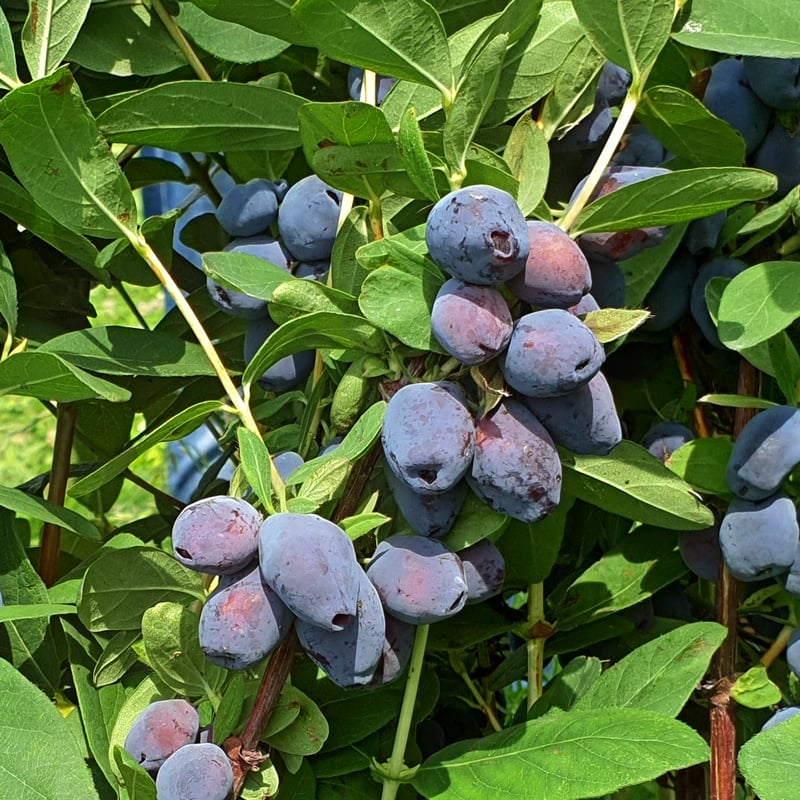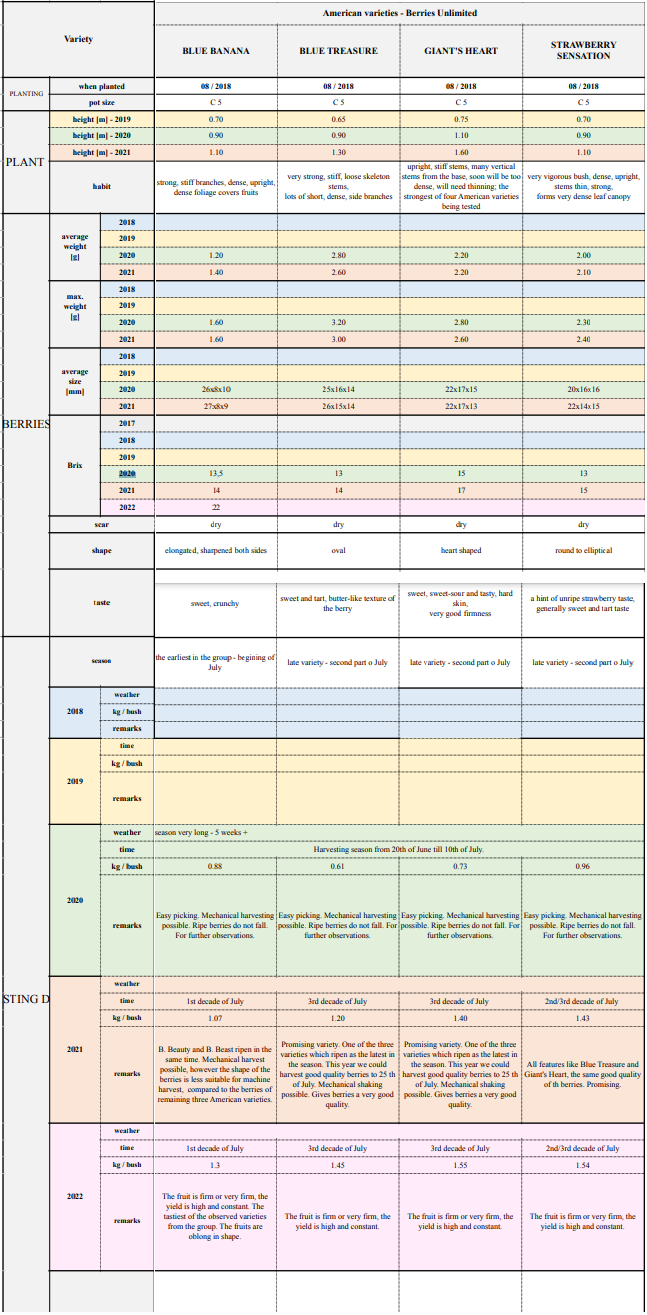Honeyberry Growing Information

Shipping and Initial Care
Please note that shipping is always stressful for plants. Be sure to water your plant upon receiving it. The best way to safeguard your plants is to keep them in a shaded, warm, protected area. Typically, it can take 1–3 days for a plant to perk up after arriving at its new home.
Choosing Cultivars
Growing honeyberry plants and bushes is easier than you might imagine. The agricultural practices in many respects are similar to those used for cultivating traditional fruit crops. Honeyberry cultivars (varieties) vary widely between the U.S.D.A.’s agricultural hardiness zones. It is imperative that you choose a variety that is not only rated for your zone but also produces the quality of honeyberries you desire.
Berries Unlimited offers a wide range of honeyberry cultivars for U.S.D.A. hardiness zones 2 through 8. Zones 2–4 are ideal for keeping plants happy, while zones 5–9 are possible but require more attentive watering during the hot season.
If you are unsure of your hardiness zone or need help choosing from the many fine varieties available, our staff will be happy to assist you in making the right choice. We can also help with wholesale purchases of honeyberry plants!
Site and Soil
One of the advantages of honeyberries is their ability to grow even in clay soil in the wild. The soil should consist of about 70% native/common soil and 30% professional-grade soil. Although honeyberries grow well in most soils, the ideal environment is loose, well-drained, and rich in humus, since their root systems spread close to the surface.
The ideal soil pH is 6.5, but honeyberries can grow in a wide range between 5 and 8.
Planting
When planting honeyberries, space your plants at least 5 to 7 feet apart, as certain varieties can reach up to 7 feet in diameter. To ensure enough space between rows, plant rows at least 14 feet apart from center to center, so you’ll have room to collect berries and maintain the plants.
When planting 2- to 4-year-old honeyberries, dig holes 10 to 12 inches deep and 10 to 12 inches in diameter. Rows should run from south to north.
Mulching
Mulching significantly increases honeyberry growth and yield. Decomposing mulch not only helps improve soil structure but also aids in nutrient uptake by the roots. Mulching maintains uniform soil moisture, reduces soil temperature, and controls weeds. However, leave a mulch-free spot immediately after planting to allow the roots to establish.
Berries Unlimited highly recommends using leaf mulch. It is best to apply mulch before winter and remove most of it in early spring to prevent overwatering or overheating the roots.
When applying mulch, keep it two inches below the base of mature bushes (3+ years old), since honeyberry roots are close to the surface. For smaller plants, mulch very lightly around stems (no more than 1/5 inch) after they have fully rooted, just to cover the carpet-type surface roots.
Apply mulch four inches deep and 24–36 inches around honeyberry bushes before winter. If your soil is clay, you can add additional mulch.
Weed Control
Prevent weed growth around honeyberry crowns by mulching, cultivating, or applying herbicides labeled specifically for honeyberries. Do not cultivate more than two inches deep within rows, since most honeyberry roots are in the top 5 to 7 inches of soil.
To reduce root injury, mulching within the rows is recommended to suppress weeds. You can leave some grass between rows to prevent mud and help maintain balanced soil moisture.
Pruning
A good-sized, healthy canopy is needed to support fruit growth. Pruning encourages the production of large, high-quality fruit and promotes earlier blooming. Fruit is produced on one-year-old wood, and the largest berries grow on the most vigorous shoots.
When pruning, shape the bush by removing dead and diseased wood. For new bushes, prune only to remove any dead or dying branch parts. After the fifth year, prune annually in late winter while the bushes are dormant and before the buds swell.
Proper pruning removes entire branches to maintain a manageable number of vigorous main stems, reduce shading inside the bush, and stimulate new shoot growth. Avoid excessive pruning, as it will greatly reduce that year’s crop.
Keep the bush open by cutting out weak, old stems that no longer produce strong new shoots. Retain 4–6 vigorous older stems and 1–2 strong new shoots per mature bush. The new shoots will eventually replace the older ones.
It is important to maintain a balance between berry production and new shoot growth to ensure proper yields. Avoid cutting off the tops of shoots, as they contain the most flower buds—your main crop—unless they are damaged or broken.
Fertilization
Fertilizer application is often necessary to maintain an optimal nutrient balance for honeyberry growth. Poor vigor and leaf discoloration often indicate nutrient deficiency. Base your initial fertilizer use on a soil analysis.
For established bushes, use leaf and soil analysis along with observation of plant vigor to determine fertilizer needs. Distribute fertilizer evenly within the root zone and avoid concentrating it near the crown.
During the growing season, fertilize three times:
-
Early spring: Apply ammonium nitrate (30 g per 2 sq. ft).
-
May: Apply a 10-10-10 fertilizer.
-
Fall (October): Add manure once every two to three years.
Adjust your fertilization plan based on your specific soil type.
Watering and Irrigation
Young honeyberry bushes require frequent watering since their root systems are shallow, usually less than 18 inches deep. Do not allow the soil to become excessively dry. Signs of inadequate moisture include reddened foliage, wilting, browning leaf margins, weak shoots, early leaf drop, and decreased fruit set.
Water frequently enough to keep the soil moist but not saturated. Honeyberry bushes need at least 1–2 inches of water per week. Do not water after early September unless the soil is very dry.
Install a rain gauge (with a two-inch or greater diameter) in the field to monitor precipitation. Honeyberries can be irrigated effectively using either sprinkler or drip systems. Drip irrigation delivers water directly to the rooting area, keeping foliage dry and reducing weed growth between rows. Mulching will also help reduce watering frequency.
Honeyberries are known for their tolerance to heat, drought, and even occasional overwatering, but take extra care with young or newly planted bushes.
Pollination
Bees pollinate honeyberry bushes. In many cases, wild bees are sufficient, but bumblebees are even more effective pollinators than honeybees.
Honeyberries require cross-pollination because their male and female reproductive organs develop at different times. For successful fruit production, you need at least one to five different varieties.
Honeyberry Summer Dormancy
Be aware that after plants produce new branches and leaves, and as temperatures rise, honeyberries (especially in Zone 7) enter summer dormancy sooner and remain dormant longer through the hot season.
Plants may develop mold on their leaves due to overhead watering or heavy spring rains. Leaves may then appear unhealthy or damaged—this is normal.
In hotter climates, leaves may drop, resembling pre-winter leaf fall. Don’t worry—this simply indicates the plants are entering summer dormancy to prepare new buds: some that will open later in the cooler fall weather, and others that will form next spring’s crop.
Harvesting
Honeyberries are famous for fruiting early—at least two weeks before strawberries. The fruiting period lasts 2–3 weeks, depending on the variety. Honeyberries can produce fruit for 30 years or more and often begin bearing as early as their first year, which is a major advantage for growers.






